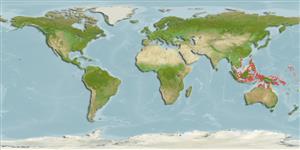>
Ovalentaria/misc (Various families in series Ovalentaria) >
Pomacentridae (Damselfishes) > Pomacentrinae
Etymology: Dischistodus: Greek, di = two + Greek, schistos = fissile stone, Plinius + Greek, odous = teeth (Ref. 45335).
More on author: Cuvier.
Environment: milieu / climate zone / rango de profundidad / distribution range
Ecología
marino asociado a arrecife; no migratorio; rango de profundidad 1 - 8 m (Ref. 7247). Tropical; 21°N - 20°S
Western Pacific: Indonesia, Philippines and northern Australia.
Tamaño / Peso / Age
Madurez: Lm ? range ? - ? cm
Max length : 11.5 cm SL macho / no sexado; (Ref. 7247)
Short description
Claves de identificación | Morfología | Morfometría
Espinas dorsales (total) : 13; Radios blandos dorsales (total) : 13 - 14; Espinas anales: 2; Radios blandos anales: 13 - 14.
Body shape (shape guide): fusiform / normal; Cross section: compressed.
Adults inhabit silty lagoon and coastal reefs around coral outcrops and seagrass beds (Ref. 9710). Often adjacent to clear mangrove coasts among rubble and Sargassum algae, to a few meters depth (Ref. 48636). Oviparous, distinct pairing during breeding (Ref. 205). Eggs are demersal and adhere to the substrate (Ref. 205). Males guard and aerate the eggs (Ref. 205). Diurnal species (Ref. 52881).
Life cycle and mating behavior
Madurez | Reproducción | Puesta | Huevos | Fecundidad | Larva
Oviparous, distinct pairing during breeding (Ref. 205). Eggs are demersal and adhere to the substrate (Ref. 205). Males guard and aerate the eggs (Ref. 205).
Allen, G.R., 1991. Damselfishes of the world. Mergus Publishers, Melle, Germany. 271 p. (Ref. 7247)
IUCN Red List Status (Ref. 130435: Version 2025-1)
Threat to humans
Harmless
Human uses
Herramientas
Special reports
Download XML
Fuentes de Internet
Estimates based on models
Preferred temperature (Referencia
123201): 27.6 - 29.3, mean 28.8 °C (based on 1291 cells).
Phylogenetic diversity index (Referencia
82804): PD
50 = 0.5078 [Uniqueness, from 0.5 = low to 2.0 = high].
Bayesian length-weight: a=0.01479 (0.00651 - 0.03363), b=3.00 (2.81 - 3.19), in cm total length, based on LWR estimates for this (Sub)family-body shape (Ref.
93245).
Nivel trófico (Referencia
69278): 2.0 ±0.00 se; based on food items.
Resiliencia (Referencia
120179): Alto, población duplicada en un tiempo mínimo inferior a 15 meses (Preliminary K or Fecundity.).
Fishing Vulnerability (Ref.
59153): Low vulnerability (10 of 100).
🛈
Nutrients (Ref.
124155): Calcium = 123 [64, 213] mg/100g; Iron = 0.836 [0.478, 1.391] mg/100g; Protein = 18.4 [17.2, 19.5] %; Omega3 = 0.118 [0.069, 0.200] g/100g; Selenium = 18.1 [9.9, 36.2] μg/100g; VitaminA = 129 [35, 457] μg/100g; Zinc = 2.48 [1.66, 3.57] mg/100g (wet weight);
